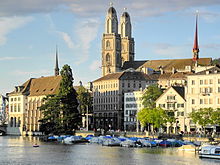Limmatquai
 Limmatquai | |
| Former name(s) | Sonnenquai; Rathausquai |
|---|---|
| Type | pedestrian zone, road, tramway |
| Length | 1 kilometre (0.6 mi) |
| Addresses | Limmatquai |
| Location | Zürich, Switzerland |
| Postal code | 8001 |
| Coordinates | 47°22′23″N 8°32′34″E / 47.372944°N 8.542767°E |
Limmatquai is a street in the
The Limmatquai has its southern end adjacent to the Quaibrücke bridge and Bellevueplatz square, where the Limmat flows out of Lake Zürich. Its northern end is at the Bahnhofbrücke bridge and Central plaza. Between the Quaibrücke and the Bahnhofbrücke, the river is crossed by four other bridges all of which connect to the Limmatquai; from south to north these are the Münsterbrücke, Rathausbrücke, Rudolf-Brun-Brücke and Mühlesteg.
For most of its length, the street runs directly alongside the river, with buildings only on its eastern side, and with a clear view across the river to the west. The only buildings abutting the street from the west are the
History

In the 12th and 13th century, the houses alongside the east bank of the Limmat were built directly on the shore, and were accessed from Oberdorfstrasse and Niederdorfstrasse on their landward sides. Over the course of the following centuries, the Limmat was increasingly channeled, and it can be demonstrated that the right bank of the Limmat is now up to 28 metres (92 ft) in front of the original bank. Although the Limmatquai as a through road along the river side dates from the 19th century, it was actually built in several sections at different times and under different names, and the name Limmatquai has only applied to the full length of the current street since 1933.[2][3]

The section downstream of the Marktgasse lane and the Rathaus was originally known as Marktststrasse or Altes Limmatquai, and was built in two stages, south of Rosengasse between 1823 and 1825, and to the north between 1855 and 1859. The section between the Rathaus and the steps up to Grossmünsterplatz was originally known as Rathausquai and was built in 1835/36, along with the Münsterbrücke. The section upstream of the steps was originally known as Sonnenquai and was built between 1835 and 1839. In the years 1887 to 1891 the whole street was broadened, and the Limmatquai assumed its present appearance.[2][3]
Points of interest
The churches of

Views across the river from the Limmatquai include the . The Limmatquai is also one of the main attractions for tourists, and has many small shops, cafés and restaurants.
Transport

Most private vehicles are prohibited; the area is the largest pedestrian zone of Zürich. Since 25 September 2004, the driving of motor vehicles, motorcycles and scooters is forbidden, except for goods transport, traffic towards
Future developments
According to the project Riviera, the waterfront promenade between
Culture

The best-known event on the Limmatquai is the annual Sechseläuten parade which traverses the street on its way to Sechseläutenplatz.
The fictitious 2007 Swiss mystery film
Between April 2014 and January 2015, an art installation known as the Hafenkran or Zürich maritim project was present on the Limmatquai. The installation comprised an old harbour crane from Dresden, together with a number of bollards and a port horn located on different high-rise buildings in Zürich. The installation proved controversial, and polarized the public and the political establishment of Zürich.[7]
Bibliography
- Das Limmatquai vor und nach der Neugestaltung. Aufenthaltsnutzung, Fuss- und Veloverkehrsaufkommen im Vergleich der Jahre 2004-2005-2008. Published by Tiefbau- und Entsorgungsdepartement der Stadt Zürich, Zürich 2009.
References
- ^ Grün Stadt Zürich (May 2006). "Vom Bürkliplatz zur Sukkulenten-Sammlung" (PDF) (in German). Grün Stadt Zürich. Retrieved 2015-01-06.
- ^ a b Gebrüder Dürst. "Limmatquai" (in German). alt-zueri.ch. Retrieved 2015-01-06.
- ^ a b Gebrüder Dürst. "Central" (in German). alt-zueri.ch. Retrieved 2015-01-08.
- ^ "Stadt Zürich - Zürich City - Transport Map" (PDF). City of Zürich. Retrieved 2016-01-08.
- ^ "Limmatquai" (in German). Polizeidepartement Stadt Zürich. Retrieved 2015-01-06.
- ^ "Neugestaltung Utoquai und Limmatquai" (in German). Tiefbau- und Entsorgungsdeparement Stadt Zürich. 2013-06-13. Archived from the original on 2015-01-15. Retrieved 2015-01-08.
- ^ Oliver Graf (2015-09-03). "Der Hafenkran ist weg – doch die Initiative ist immer noch da" (in German). Limmattaler Zeitung. Retrieved 2015-09-04.
External links
 Media related to Limmatquai at Wikimedia Commons
Media related to Limmatquai at Wikimedia Commons- Limmatquai page from the Zürich Tourist Service
- A history of the Limmatquai (in German)
